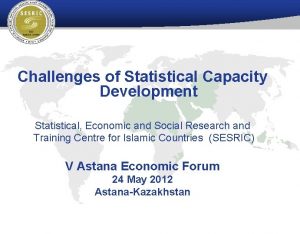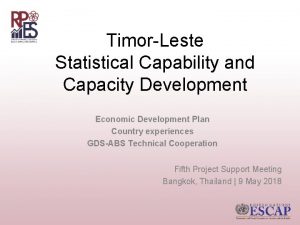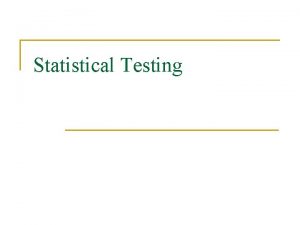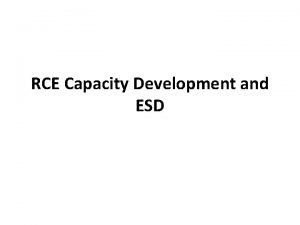STATISTICAL CAPACITY DEVELOPMENT 4 0 2 Why capacity








- Slides: 8

STATISTICAL CAPACITY DEVELOPMENT 4. 0

2 Why ‘capacity development 4. 0’? • Limitation of traditional approaches (e. g. often confined to a technical exercise; strong focus on training only; incentives misalignment) • New ‘data ecosystem’ (new skills and resources are required to leverage ‘big data’ opportunity, and emergence of new data producers) • More demanding users (more, faster and better data is required by users for their decision-making processes)

3 Where does it come from? Literature on capacity development: Eg. OECD (2016), Skills Matter: Further Results from the Survey of Adult Skills Eg. • Examples shared by Task Team members • Denney, L. and Mallett, R. (2017) Service delivery and state capacity • Bockstael, E. (2017). Critical Capacity Development: An Action Research Approach in Coastal Brazil • Andrews, M. , Pritchett, L. , & Woolcock, M. (2013). Escaping capability traps through PDIA Eg. • Taylor, M. (2016) The Political Economy of Statistical Capacity: A Theoretical Approach. • Devarajan, S. (2013). Africa's statistical tragedy Soft Skills Political aspects Implementation Results Eg. 2017 DCR Report Open Data Watch (2015): Partnerships and Financing for Statistics: Lessons Learned from Recent Evaluations

4 What is ‘statistical capacity development 4. 0’? “A process through which producers and users of data obtain, strengthen and maintain the capabilities to navigate through the data revolution so that it benefits society at large and improves the quality of life of all. ”

5 What are the ‘capabilities’? Targets Capacity development is targetting Levels Resources Individual Skills and Knowledge Management At these levels Organization Politics and power System Incentives From: Denney, L. and Mallett, R. with Benson, M. S. (2017) Service delivery and state capacity: findings from the Secure Livelihoods Research Consortium. London: Secure Livelihoods Research Consortium.

6 Capacity Development 4. 0 matrix Target/Level Resources Individual Organisational Education Human Resources Work experience Budget System Laws, regulations and reference frameworks Funds infrastructure Plans (NSDS, sectoral…) Existing data Infrastucture (physical assets, IT, etc. ) Skills & Knowledge Technical skills Methods, practices and QC Work ‘Know-how’ Standards and regulations Autonomy & problem solving Creative thinking Management Politics & Power Incentives Innovation Institutional infrastructure Data literacy Talent management Time management and prioritisation Leadership Strategic planning NSS co-ordination Organisational design Data Ecosystem co-ordination Strategic thinking Transparency Teamwork & collaboration Change management Communication & negotiation skills Workplace politics Strategic networking Fundraising strategies Career expectations Career development Income Work ethic & self-motivation Compensation and benefits Organizational culture Status Reputation/Visibility HR Management Advocacy strategy Relationship between producers Relationship bet. producers and users Institutional autonomy Accountability Policy preferences Stakeholders' interests and strategies Public support/endorsement Legitimacy

7 What have we (Task Team) done so far? • Discussed and reviewed literature to produce this framework! • Mapping of current practices in capacity development’ • Survey following the new approaches to capacity development • Draft report on ‘Measuring Statistical Capacity Development’ • This workshop!!

8 What are the next steps? • Fine-tuning and producing agreed outputs for our PARIS 21 board meeting, • Feeding into national and international meetings, such as CT-GAP, World Data Forum, Bristol Data Festival and others, • Kick-starting and influencing new data initiatives such as the creation of a Global Fund for Data














